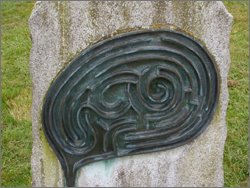Those Amazing Mazes

They are sometimes called mazes or labyrinths but there is a slight distinction between the two terms. Generally, mazes are considered easier to negotiate since they have no blind alleys or dead ends. Labyrinths, on the other hand are considered a little more challenging. Webster’s Dictionary defines a labyrinth as “...a place constructed of or full of intricate passageways and blind alleys...something extremely complex or tortuous in structure, arrangement or character....” In any event, most writers tend to use the term maze and labyrinth interchangeably, as I will do in this column.
Mazes have been found throughout the world and appear to have early origins. In the 5th century BC, a Greek traveler, Herodotus, discovered a labyrinth in Egypt. He was so impressed with the size and complex nature of the labyrinth that he wrote “I found it greater than words could tell...even the pyramids were surpassed by the Egyptian labyrinth.” Herodotus also states that the labyrinth was built on two levels had 3,000 chambers and that a massive stone wall encircled the structure.
Some believe that mazes were created to admonish people who had behaved badly and therefore needed to reflect on their past conduct. These individuals would be placed in the center of the maze and asked to escape. In doing so, they would experience dead ends, blind alleys, interlocking triangles and concentric circles. It was hoped that as an individual tried to escape the confinements of a maze, he might equate those experiences to real life, and therefore consider his options more carefully and make better decisions in the future.
Seen in this photograph is an unusual headstone to Michael Ayrton who was known as a master maze builder. It holds an 18” double spiral bronze labyrinth replica of the Arkville labyrinth Ayrton in New York. The tombstone is located in St. Botolph’s churchyard in Essex, England. It is located on the north east corner of the churchyard on left-hand side of the gravel path. Visitors to Ayrton’s graveside have run their fingers through the bronze plaque trying to locate the beginning and end of the puzzle. Even in death, Ayrton still has the ability to perplex people.
An excerpt in Extraordinary Places…Close to London.


